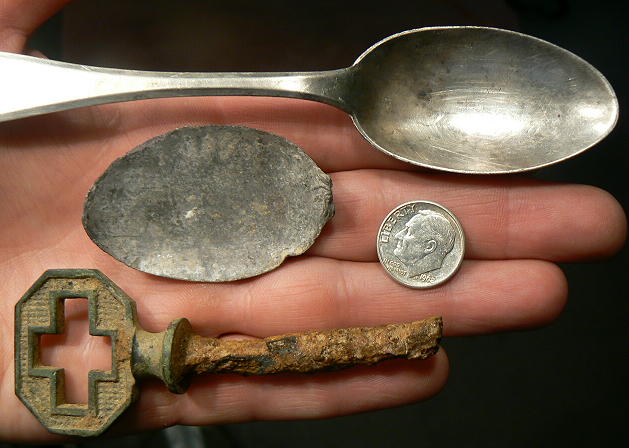Those who read me know what an “everything but the girl” hunt is — you do all the right things, pull all the right tells, yet go home silverless. We’ve all been there, But, of course, it can be worse. You do all the right things, pull all the right big fish tells, and go home with a 1962D rosie. Well, any day with silver is a good day, so who am I to whine? I got the girl, after all.
But lets roll this and try to make it make sense. Back to the site of the last couple of entries, expand the grid, and the first target of the day was the ’62D rosie. Woohoo. Early silver is special — it means the rest of the hunt is on the house. It was a hard, ferrous affected silver, but I was fairly sure it was gonna be a silver before I dug it. We’ll take it. Nice to reaffirm that dimes are possible at this place.
Next was was yet another deep, big, high tone, a problem that plagues this place, and, coupled with the hard dirt and rocks, makes it possibly the toughest place I’ve ever detected, and, after digging deep for about 15 minutes, out pops a complete sterling silver spoon. Are you kidding me? This was 10 feet from the first base line of a baseball field that dates to the 30s. How did the competition miss it? Is it cause its deeper than they expect, and then when they get there, if it ain’t coin shaped, they assume it its trash and leave it before identifying it? Who knows? Never assume anything. Follow thru until you’ve identified both the metal and the object, especially if the site is wickedly old. This is only the second or third complete silver spoon I’ve ever dug, and I’ve never dug one at a normal run of the mill park where you’d expect the competition to have gotten it 20 years ago.
But, there’s more. More spoonage that is. First multi-spoon hunt in my career. Maybe I should track this on the stats page. The next one came in as a slam dunk silver quarter, and it took me forever to find it, cause there was all this coal like stuff in the hole which kept whacking the PP. I only got the bowl, but it seems really old. Tests as silver, but the way the acid worked on it, it looks like coin silver (900 silver), rather than sterling. That means its prolly in the 200 year old range. Where’s the handle? Where’s the 200 year old silver quarter that should have been there? Where’s the supermodel? I sort of felt jinxed, working thru this brutal site, to come up with a complete silver spoon, then a 200 year old silver spoon bowl that should have been a silver Q dated 1813.
But, there is actually more. Yet another miss on the supermodel. Got a wicked deep iffy high tone, which I was sure was gonna be an affected, old silver Q or half, and turned out to be this old looking key. Old keys are cool, but this one is kinda lame cause its missing the key part. Looks like the handle was copper, yet the stem (and presumably the key part), was ferrous. Who makes a key like this? Any key experts reading? The amazing thing about this was that I hit the ferrous part at about 7-8 inches, and it was sticking straight up. I figured — yet another nail — but I always remove them to see if we can hear the high tone better afterwards, and out comes the copper handle, which must have been at 10-11 inches. Amazing the E-Trac heard that thru the mineralized ground, thru the ferrous stem, and onto the high tone handle at 10 inches. Unbelievable. Would have been more unbelievable if it were a bust quarter. Where’s the supermodel? That second spoon bowl and key seem really old. Oh well.
My wife says the key is really cool. I agree. Too bad about the business end being ferrous.


Wow! Awesome stuff! I really need to meet Wife sometime, we think alike!